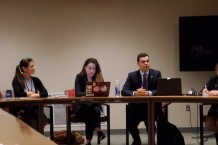This article is cross-posted from the United Nations Association - USA website, view the original here.
by Carlos Rodriguez-Cruz y Celis
originally published on 16 May 2019
* * *
Last week, I had the pleasure of joining the UNA-USA delegation to the 2019 Preparatory Committee for the Nuclear Non-Proliferation Treaty Review Conference. We gathered in New York City with diplomats from across the globe to discuss progress in moving toward a world free from nuclear weapons.
The Nuclear Non-Proliferation Treaty (NPT) is the cornerstone of the legal architecture that governs the use, development, and possession of nuclear weapons. Every five years, the State Parties to the NPT gather to discuss progress on the commitments and legal obligations under the Treaty. The event brings together diplomats, academics, and civil society representatives from across the world, who convene at the United Nations for two weeks of intense deliberations. This year’s Preparatory Committee (PrepCom) held increased significance, as the international community prepares for the 2020 NPT Review Conference. Next year’s Review Conference will be vital for gauging the health of the global nonproliferation regime. As tensions continue to rise in East Asia, the Middle East, and Eastern Europe, finding common ground & promoting dialogue will become crucial for a successful outcome.
The NPT lays out three main obligations for its signatories, and the bulk of the discussions during PrepCom focus on these pillars: nuclear nonproliferation, peaceful uses of nuclear energy, and disarmament. The disarmament obligations remain the most divisive issue, especially as non-nuclear weapon states become increasingly disenchanted by the lack of progress on this front. The last Review Conference, which took place in 2015, ended without States Parties reaching consensus on an outcome document, a failure that has loomed over the deliberations ever since. In finding common ground in Preparation for next year’s Review Conference, State Parties to the NPT should promote the entry-into-force of the Comprehensive Nuclear-Test-Ban Treaty (CTBT) as a confidence-building measure. The CTBT’s contribution to the global security architecture, which over a dozen States highlighted during the General Debate at this year’s conference, unite nuclear and non-nuclear weapon states.
I was delighted to meet with young leaders who are taking action within their communities to raise awareness about the need for youth engagement in nuclear issues. Marzhan Nurzan, a peace activist from Kazakhstan, shared her work in mobilizing students around nuclear issues. Meanwhile, U.S. activist Shelby Surdyk spoke about her plans to organize a youth conference for high schoolers in Alaska in April 2020, to shed light on the continued relevance of nuclear issues. Seeing young women at the forefront of these discussions was inspiring, because the lack of female representation in the nuclear security realm has created a barrier for achieving successful outcomes. The NPT process requires a whole-of-society approach, and increasing representation is the first step to ensuring better outcomes. This year’s PrepCom illustrated the importance of engaging youth in nuclear nonproliferation and disarmament, and I am hopeful that our generation can bring about a world free of nuclear explosions.
